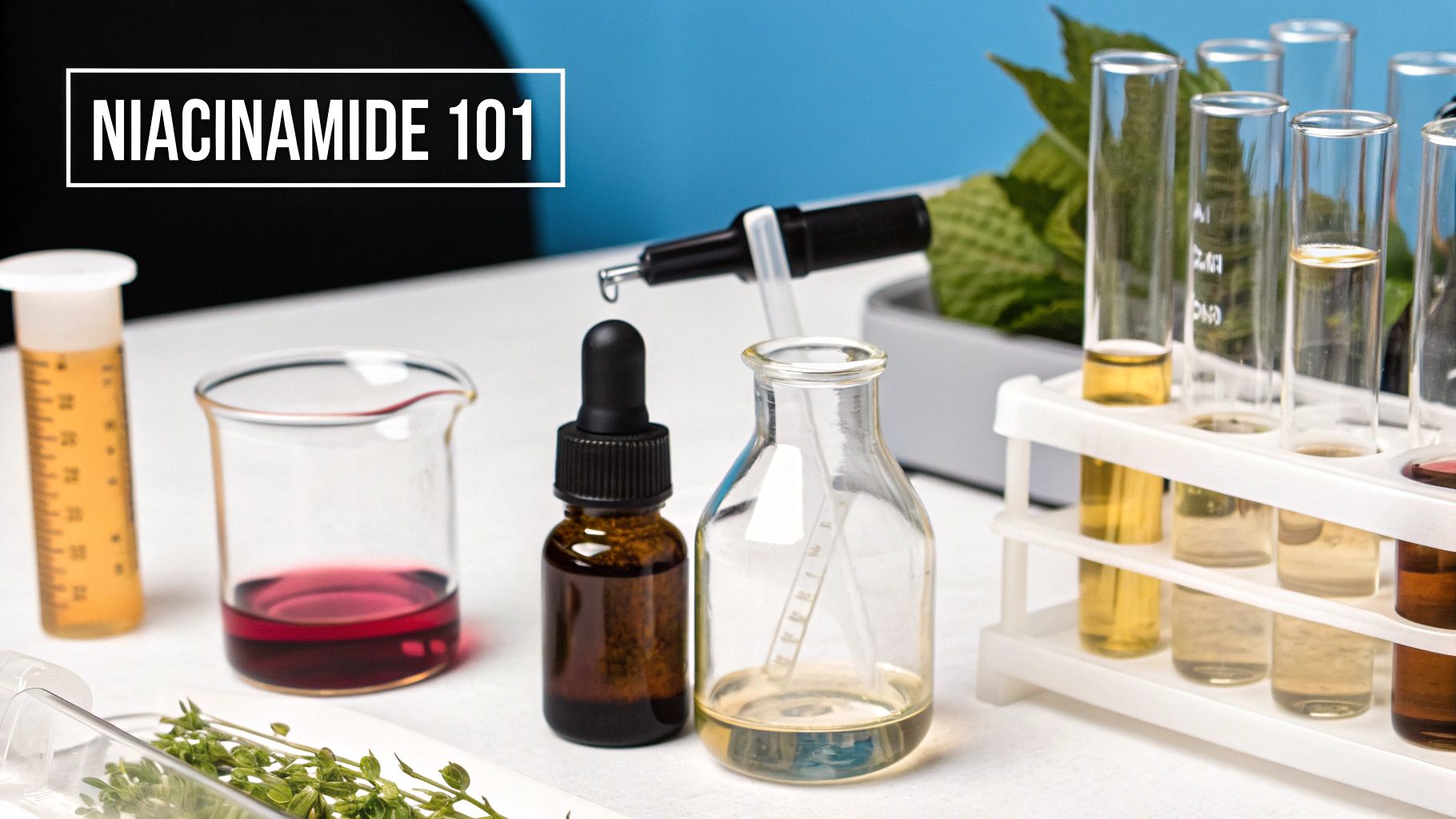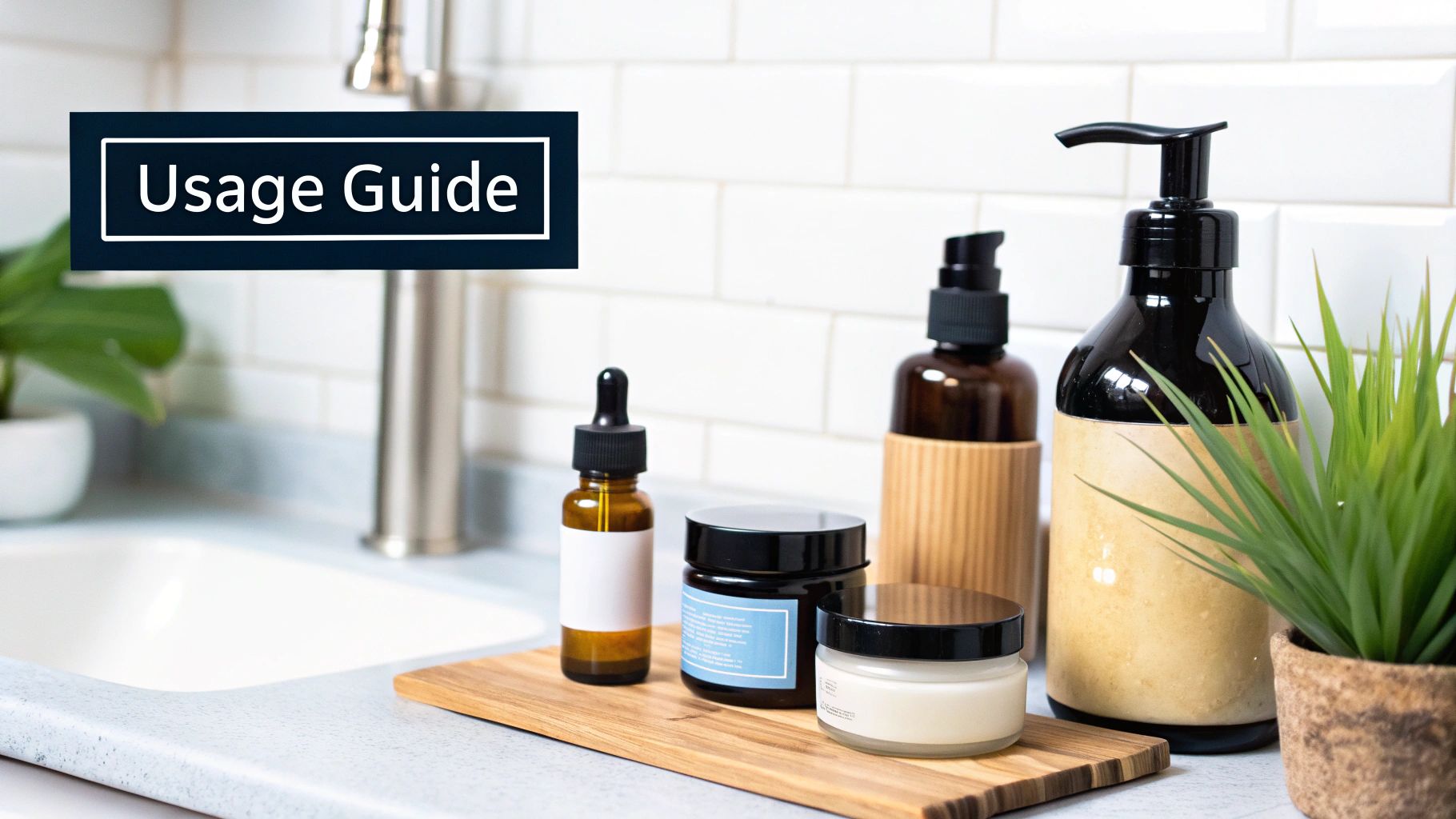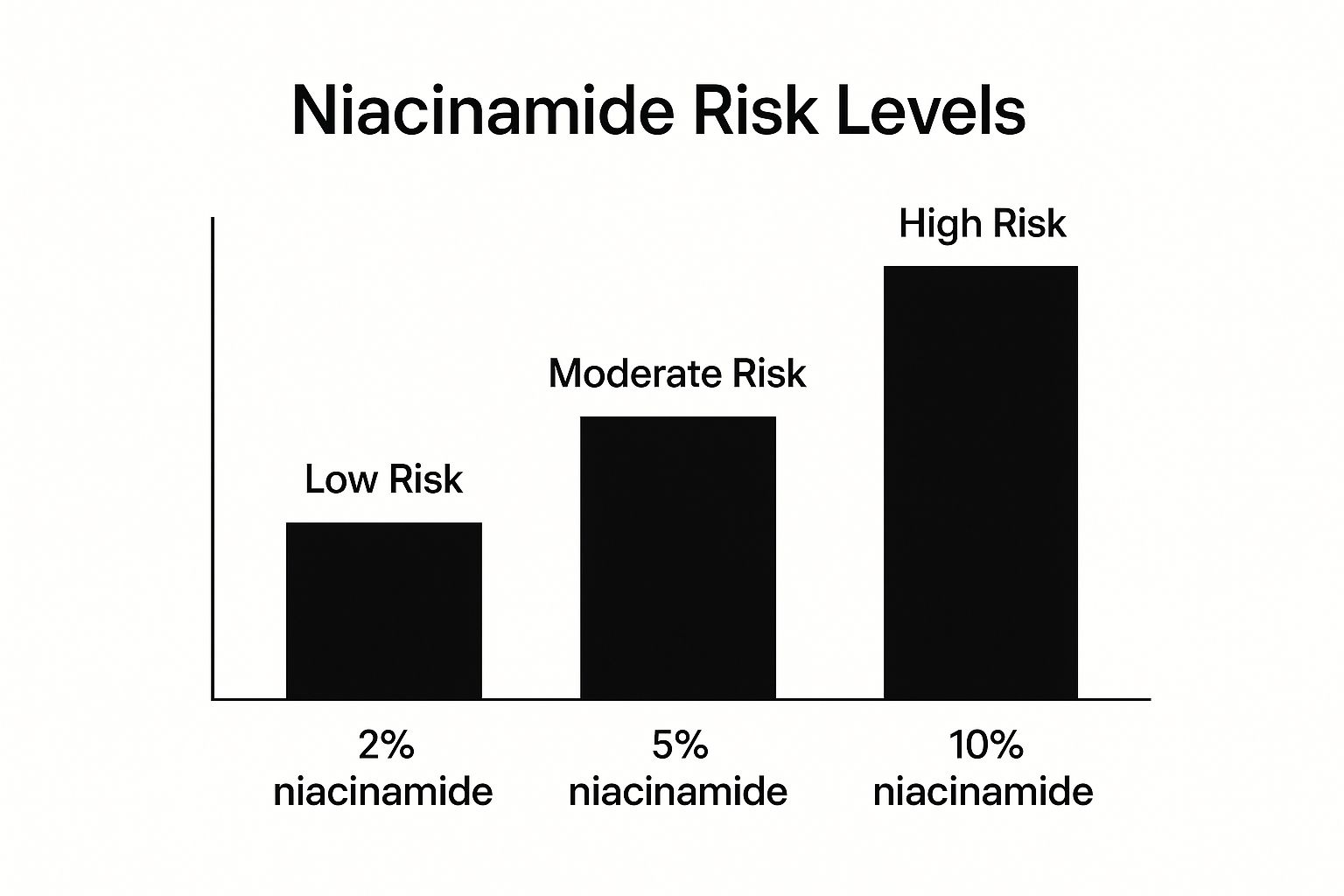
Niacinamide for Skin: Your Guide to a Radiant Complexion
Share
Welcome to your definitive guide on niacinamide, the skincare ingredient that dermatologists and beauty editors can't seem to stop talking about. If you're looking for one ingredient that does a bit of everything, you've found it. Think of niacinamide not just as another step in your routine, but as a key component in powerful skin care products that tackle everything from redness and large pores to uneven skin tone.
The Ultimate Guide to Niacinamide Skin Care Products

We’re here to demystify why this powerhouse has become such a cornerstone of effective skincare, especially in the UK where we look for hardworking, multi-benefit products. This guide will walk you through exactly what niacinamide does, how it can transform your skin, and the best way to choose the right skin care products to get that clear, resilient, and radiant complexion we all want.
Let’s dive in.
Your Skin's Multitasking Manager
So, what exactly is niacinamide? Also known as nicotinamide, it's a water-soluble form of Vitamin B3. It's an essential nutrient that our bodies can't store, which means we need to top it up regularly. While you can get some from your diet, applying it topically through skin care products is the best way to see targeted benefits.
Think of it as a brilliant project manager for your skin cells. It helps them carry out essential jobs, strengthens their defences, and improves communication between them so they function more efficiently. The result? A calmer, smoother, and more balanced complexion.
Niacinamide at a Glance: Key Benefits and Actions
To give you a quick snapshot of what this ingredient can do for you, here’s a simple breakdown of its primary benefits when used in skin care products.
| Skin Concern | How Niacinamide Helps | Best For |
|---|---|---|
| Redness & Irritation | Soothes inflammation and calms the skin. | Sensitive, acne-prone, or rosacea-prone skin. |
| Enlarged Pores | Helps regulate sebum and improves skin elasticity. | Oily and combination skin types. |
| Weak Skin Barrier | Boosts ceramide production to strengthen the skin. | Dry, dehydrated, or sensitised skin. |
| Uneven Skin Tone | Reduces the transfer of pigment to skin cells. | Skin with dark spots or post-acne marks. |
| Fine Lines & Wrinkles | Supports collagen production for a smoother look. | Ageing or mature skin. |
As you can see, its versatility is its greatest strength, making it a valuable addition to nearly any skin care product designed for every skin type and concern.
Why Niacinamide Is a Staple in Modern Skin Care Products
The buzz around niacinamide isn't just a fleeting trend; it's backed by solid science and very real results. Its popularity lines up perfectly with the "skinimalism" movement, where people are looking for fewer, more effective products. Niacinamide fits this role perfectly with its anti-inflammatory and barrier-boosting abilities.
Its core benefits are what make it an indispensable part of any modern skincare collection. Here's a quick look at its main jobs:
- Strengthens the Skin Barrier: It boosts the production of ceramides—the fatty acids that act like mortar holding your skin cells together. This makes your skin stronger and better protected from environmental damage.
- Reduces Redness and Inflammation: Its calming properties are a godsend for soothing irritation, whether it's from acne, rosacea, or general sensitivity.
- Minimises Pore Appearance: By keeping oil production in check and improving skin elasticity, it helps pores appear smaller and less obvious.
- Evens Out Skin Tone: It cleverly interrupts the process that causes dark spots, leading to a much brighter and more even-toned complexion over time.
Learning how to slot it into your daily regimen is a key step, which you can learn more about by reading our guide to creating the ultimate skincare routine for healthy skin.
How Niacinamide Rebuilds and Refines Your Skin
To really get why niacinamide is such a powerhouse for your skin, we need to go a little deeper than just what you see in the mirror. Let's look at how it works on a cellular level. Forget the dense science for a moment; we can think of it as a multi-talented manager for your skin, expertly handling three key jobs: rebuilding your skin’s defences, controlling oil, and evening out your complexion.
First up, think of niacinamide as the ultimate foreman for your skin's protective barrier.
Strengthening Your Skin's Natural Shield
Picture your skin's outermost layer as a well-built brick wall. The skin cells are the bricks, and the natural fats—like ceramides and cholesterol—are the mortar holding it all together. When that wall is solid, it’s brilliant at keeping moisture locked in and pesky irritants like pollution and bacteria out.
But if that mortar starts to crumble, you get gaps. This is what we call a compromised skin barrier, and it’s the culprit behind dryness, sensitivity, and redness. This is where niacinamide gets to work. It essentially tells your skin cells to start making more of that crucial mortar, especially ceramides. Studies have actually shown that applying skin care products with niacinamide can significantly boost ceramide production.
With more ceramides, the mortar gets reinforced, patching up any weak spots in your skin's wall. The result? A stronger, more resilient barrier that’s much better at holding onto hydration and fending off environmental attacks. Your skin just feels calmer, more comfortable, and less prone to reacting.
Key Insight: Niacinamide doesn’t just give your skin a temporary moisture boost. It teaches your skin how to build a stronger barrier for itself, leading to lasting improvements in hydration and resilience.
A Smart Controller for Oily Skin and Pores
If you’re dealing with oily or combination skin, niacinamide acts like a clever traffic controller for your pores. When your skin produces too much oil (sebum), it can lead to clogged pores, breakouts, and that shiny look nobody wants. Niacinamide helps dial this process back to a healthy level—it doesn't shut off oil production completely, but it makes sure there’s just enough to keep your skin happy without causing trouble.
It helps normalise the flow of sebum from your glands, preventing the kind of "traffic jams" that clog and stretch out your pores. When oil production is balanced, pores are far less likely to get congested and look bigger than they are.
But that’s not all. Niacinamide also gives your skin’s elasticity a helping hand. When your skin is firm and bouncy, the walls of your pores have better support, helping them to keep their shape. It's a bit like pulling the threads of a fabric tighter; the weave becomes finer, and the gaps naturally look smaller. This one-two punch of controlling oil and improving elasticity is what makes it so good for visibly refining pore size. By making the skin’s surface smoother, it’s a big step in learning how to improve skin texture for that flawless look.
An Interceptor for Uneven Skin Tone
Finally, let's get into how niacinamide helps brighten your complexion and fade discolouration. Those frustrating dark spots from sun damage or the marks left behind by old blemishes (post-inflammatory hyperpigmentation) happen because of an overproduction of melanin, the pigment that gives our skin its colour.
Deep in your skin, specialised cells called melanocytes act like tiny pigment factories. They produce melanin and package it into little parcels (melanosomes), which are then shipped up to your surface skin cells, where they show up as spots.
Niacinamide plays the role of a brilliant interceptor here. It doesn't stop the factories from producing pigment—that would be unnatural. Instead, it messes with the delivery route. Research has shown that niacinamide can block the transfer of these pigment parcels from the factory to the surface cells by up to 68%.
By getting in the way of this transfer, niacinamide stops the excess pigment from building up and becoming visible. This allows existing dark spots to fade over time while helping to prevent new ones from appearing, leaving you with a complexion that’s visibly clearer and more luminous.
Choosing the Right Niacinamide Skin Care Product for You

Now that you understand what niacinamide can do for your skin, it’s time to find the perfect product. Walking down the skincare aisle can feel overwhelming, but picking a niacinamide formula is actually quite straightforward once you know what to look for. The trick is to match the product type and strength to your skin’s specific needs.
You'll mostly find niacinamide in two forms of skin care products: serums and moisturisers. Each has a very different role to play in your routine.
Serums vs Moisturisers: Which Is Better?
Deciding between a serum and a moisturiser really comes down to what you’re trying to achieve. Think of it as choosing the right tool for the job.
-
Niacinamide Serums: These are your targeted treatments. They are typically lightweight, water-based, and packed with a higher concentration of niacinamide. Their smaller molecules allow them to penetrate deeper, making them the best choice for tackling more stubborn issues like noticeable hyperpigmentation, stubborn oiliness, or enlarged pores.
-
Niacinamide Moisturisers: These are primarily designed for hydration and supporting your skin barrier, with niacinamide included as a fantastic supporting act. A moisturiser is perfect for daily maintenance, helping to keep your skin’s defences robust while delivering a gentle, consistent dose of the ingredient. If your main goals are simply better hydration and calming down a bit of redness, this is an excellent choice.
Honestly, for most people, you don't need both. A well-formulated serum is often the most effective way to see real results from this powerhouse ingredient.
Understanding Niacinamide Concentrations in Skin Care Products
The percentage of niacinamide in a product is a big deal. But it's not a case of "more is always better"; the right strength depends entirely on your skin and what you're hoping to fix.
A good rule of thumb is to start low and go slow. Let your skin get used to the ingredient before you think about moving to a higher strength.
For anyone new to niacinamide or with sensitive skin, a concentration of around 5% is the sweet spot. We have solid research showing this level is incredibly effective for improving skin barrier function, calming inflammation, and evening out skin tone, all with a very low risk of irritation. It's a brilliant starting point for general skin health.
If you’re dealing with more persistent problems—like stubborn dark spots, uneven texture, or very oily skin—then a concentration of 10% or higher could be what you need. These more potent formulas deliver a stronger punch. In the UK, for instance, there's been a growing demand for high-strength serums, some even going up to 20%, to target severe hyperpigmentation and advanced signs of ageing. This trend goes hand-in-hand with a preference for trusted, fragrance-free formulations. You can dive deeper into these consumer preferences on GrandViewResearch.com.
What to Look for on the Ingredient List
Beyond the percentage, the rest of the formula really matters. A truly great niacinamide skin care product will be formulated with other ingredients that support and enhance its effects.
Keep an eye out for these allies on the ingredients list:
- Humectants: Things like Hyaluronic Acid and Glycerin are fantastic partners. They pull moisture into the skin, working in tandem with niacinamide for a serious hydration boost.
- Ceramides: Niacinamide encourages your skin to produce its own ceramides, but having them in the formula gives your skin barrier an immediate helping hand.
- Antioxidants: Ingredients like Vitamin E or Green Tea Extract add another layer of protection against daily environmental stressors.
Just as important is what isn't in the bottle. To get the most out of niacinamide’s calming benefits, it’s best to choose skin care products that are free from potential irritants like drying alcohols and fragrance.
How to Weave Niacinamide Into Your Skincare Routine

Bringing a new ingredient into your skincare line-up can feel a bit like a strategic puzzle. But here’s the good news: when it comes to niacinamide for skin, it’s refreshingly easy to slot in. Because it plays so well with others and is generally very gentle, you don’t have to jump through hoops to make it work.
The trick to getting the most out of it is all about placement. Think of your skincare routine like getting dressed for a chilly day – you put the thinnest layers on first. Niacinamide, especially when you’re using a serum, is one of those essential base layers.
You’ll want to apply it right after you’ve cleansed and toned, but before you reach for any heavier creams, facial oils, or your daily SPF. This simple rule of thumb ensures its water-based formula can sink straight into the skin, getting to work without having to battle through thicker skin care products.
Your Step-by-Step Application Guide
If you want to see real, lasting results, consistency is your best friend. Making niacinamide a regular fixture in both your morning and evening routines gives your skin the steady, reliable support it needs to truly thrive.
Here’s a simple framework to follow:
Morning Routine:
- Cleanse: Start with a clean slate using a gentle cleanser.
- Tone (Optional): If a hydrating toner is part of your routine, now’s the time.
- Apply Niacinamide: Pop 2-3 drops onto your fingertips and gently pat the serum across your face and neck.
- Moisturise: Seal everything in with a moisturiser that suits your skin type.
- Protect: The final, non-negotiable step. Finish with a broad-spectrum sunscreen of at least SPF 30. This is crucial for protecting all your hard work.
Evening Routine:
- Double Cleanse: First, use an oil or balm cleanser to dissolve makeup, grime, and SPF. Follow up with your regular water-based cleanser.
- Tone (Optional): A quick swipe of toner if you use one.
- Apply Niacinamide: Just like in the morning, gently pat your serum into the skin.
- Moisturise: Finish with a night cream to help your skin repair and rehydrate while you sleep.
Busting the Big Myth: Vitamin C and Niacinamide
There's a persistent rumour in the skincare world that you can't use niacinamide and Vitamin C together. This idea comes from some very old research that used pure, unstable forms of the ingredients at scorching-hot temperatures – conditions that have absolutely nothing to do with today's sophisticated skin care products.
The Modern Truth: The niacinamide and Vitamin C in your bathroom cabinet are formulated to be stable and effective. Not only is it perfectly safe to use them in the same routine, but it's actually a brilliant move. They form a powerhouse antioxidant team, working together to brighten your complexion, fend off environmental damage, and boost collagen.
So, forget what you might have heard. There's no need to split them between morning and night unless you simply prefer to. You can confidently layer them—most people apply their Vitamin C serum first, let it sink in, and then follow with niacinamide.
Tailoring Your Niacinamide Routine
While the basic steps are universal, you can absolutely tweak your routine to better match your skin's unique needs.
- For Oily Skin: You might find that a light, gel-based moisturiser after your niacinamide serum is more than enough for the daytime.
- For Dry Skin: Layering a richer, creamier moisturiser over your niacinamide is key. This will lock in that much-needed hydration and help fortify your skin barrier.
- For Sensitive Skin: The golden rule is to start slow. Introduce your niacinamide product once a day, or even every other day, for the first couple of weeks. Always, always patch-test a small area (like behind your ear) for 24 hours to check for any reaction before going all-in. This lets your skin get used to the new ingredient and minimises any risk of irritation.
Unlocking Niacinamide's Full Potential With Power Pairs
While niacinamide is a fantastic ingredient on its own, it really shines when it works with others. Think of it less as a solo artist and more as a brilliant team player that helps its partners perform even better. When you understand how different ingredients work together, you can build a skincare routine that delivers more noticeable results, faster.
Some combinations are true ‘power couples’, tackling skin concerns from multiple angles for an effect that’s greater than the sum of its parts. Let’s look at a few of the most effective pairings found in today's skin care products.
The Ultimate Hydration Duo: Niacinamide and Hyaluronic Acid
Pairing niacinamide with hyaluronic acid is probably one of the most popular combinations out there, and for good reason. It’s a godsend for anyone with dry or dehydrated skin. Hyaluronic acid is a superstar humectant; it literally pulls moisture from the air and holds it in your skin like a tiny sponge.
But what good is all that moisture if it just evaporates? That's where niacinamide comes in. By strengthening your skin’s natural barrier, it helps prevent that water from escaping. Niacinamide effectively locks in all the hydration that hyaluronic acid has drawn to the skin, keeping your face feeling plump, comfortable, and dewy all day. To really dig into this, our guide explains how hydration is the secret to youthful skin.
The Soothing Partnership: Niacinamide and Retinoids
Retinoids (like retinol) are the gold standard for tackling signs of ageing, but they have a reputation for a reason. They can often cause irritation, redness, and flaking, especially when your skin is first getting used to them. This is where niacinamide becomes an indispensable ally. Its anti-inflammatory properties are brilliant for calming the skin and soothing those unwanted side effects.
Niacinamide does more than just calm redness. It actively helps your skin build a stronger, more resilient barrier. A stronger barrier can better handle powerful ingredients like retinoids, meaning you get all the anti-ageing benefits with far less of the initial discomfort.
Using both together is a savvy move. You get the powerful cell-turnover from the retinoid and the barrier-supporting, calming effect from the niacinamide. It's the perfect combination for achieving smoother, more youthful-looking skin with minimal drama.
The Blemish-Busting Team: Niacinamide and Salicylic Acid
If you’re fighting breakouts and clogged pores, bringing niacinamide and salicylic acid together can be a game-changer. Salicylic acid is a beta-hydroxy acid (BHA), which means it can get deep inside your pores to exfoliate and dissolve the gunk—oil, dead skin cells—that causes spots in the first place.
While salicylic acid is busy clearing out the congestion, niacinamide steps in to do two things: regulate your skin's oil production and reduce the inflammation and redness that comes with a breakout. They work in perfect harmony to give you a clearer, more balanced complexion.
To help you build the most effective routine, this table shows how niacinamide plays with other popular ingredients in skin care products.
Niacinamide Combination Guide
| Active Ingredient | Combined Benefit | Best For | Application Tip |
|---|---|---|---|
| Hyaluronic Acid | Intense Hydration: Hyaluronic acid draws moisture in, and niacinamide locks it down, preventing water loss. | Dry, Dehydrated Skin | Apply hyaluronic acid to damp skin first, then layer niacinamide on top to seal it in. |
| Retinoids | Reduced Irritation: Niacinamide's calming properties minimise the redness and peeling often caused by retinoids. | Anti-Ageing Routines | Use niacinamide in the morning and your retinoid at night, or apply niacinamide first to buffer the skin. |
| Vitamin C | Potent Antioxidant Power: Together, they offer robust protection against environmental damage, brightening the skin and evening out tone. | Dullness, Uneven Tone | Apply Vitamin C in the morning for antioxidant protection, and niacinamide at night to repair. |
| Salicylic Acid | Comprehensive Blemish Control: Salicylic acid clears pores while niacinamide controls oil and calms breakout-related inflammation. | Oily, Acne-Prone Skin | Use them in the same routine, applying the thinner-textured product first. Give it a minute to absorb before the next step. |
Understanding these pairings allows you to fine-tune your skincare, creating a synergistic routine that addresses your specific concerns much more effectively.

It’s also important to pick the right strength. This visual shows that while a low concentration like 2% is very gentle, jumping straight to a 10% formula could increase the risk of irritation, particularly if you have sensitive skin. Always listen to your skin and choose a product that feels right for you.
Got Questions About Niacinamide Skin Care Products? We’ve Got Answers.
Even with an ingredient as friendly and agreeable as niacinamide, it’s completely normal to have a few questions before welcoming it into your routine. Let's walk through some of the most common queries we hear about niacinamide skin care products, so you can feel totally confident from your very first application. We'll get into realistic timelines, daily use, and how it behaves on sensitive skin.
It’s no surprise this ingredient is so popular. The UK skincare market, valued at roughly £4.34 billion in 2024, is set to expand to £5.96 billion by 2030. This growth is fuelled by people just like you, searching for effective, science-backed skin care products. Niacinamide's talent for calming inflammation, evening out skin tone, and reinforcing the skin barrier makes it a star player in this trend. You can dive deeper into these market insights and read the full research on techsciresearch.com.
How Long Until I See Results from Niacinamide?
Good skincare is a marathon, not a sprint, and niacinamide for skin is a perfect example of this. While it gets to work right away, the visible, lasting changes take time and, most importantly, consistency.
You’ll likely notice some of the initial benefits fairly quickly. Many people report better oil control and a more hydrated, balanced feel to their skin within the first 2 to 4 weeks of daily use. That mid-day shine might become a thing of the past.
For the more significant, structural improvements, you need to play the long game.
- Hyperpigmentation and Dark Spots: To see a noticeable fading of stubborn marks, you’ll want to stick with it for at least 8 to 12 weeks. This gives niacinamide enough time to get in there and effectively disrupt the process that creates those spots in the first place.
- Fine Lines and Texture: Improvements in skin smoothness and the look of fine lines also tend to appear in that 8 to 12-week window, as your skin’s collagen production gets a supportive boost.
The bottom line? Using it consistently is what unlocks the best results. It’s non-negotiable.
Can I Use Niacinamide Every Day?
Yes, absolutely! In fact, you should. Niacinamide is known for being incredibly gentle, which makes it a fantastic candidate for daily use. For the best outcome, we highly recommend working it into both your morning and evening skincare routines.
Applying it daily gives your skin a steady, constant supply of this hard-working vitamin. This allows it to continuously strengthen your barrier, keep oil in check, and calm down any inflammation. Unlike some potent actives that you have to ease into, most skin types can handle niacinamide right from the start.
A Quick Note for Sensitive Skin: If your skin is easily upset, it’s always smart to start slowly. Try applying your niacinamide product just once a day, or even every other day, to see how things go. This lets your skin get used to it before you ramp up to twice-daily use.
Is Niacinamide Good for Sensitive or Rosacea-Prone Skin?
This is where niacinamide truly shines. Its powerful anti-inflammatory abilities make it a brilliant choice for anyone with sensitive skin or conditions like rosacea. If redness, flushing, and general irritation are your main struggles, niacinamide is designed to help.
By calming that underlying inflammation, it helps take the heat out of your skin, visibly reducing redness and soothing discomfort. What’s more, its knack for strengthening the skin's barrier is a massive win for sensitised complexions. A stronger, more resilient barrier is better at defending itself against external triggers, meaning your skin becomes less reactive over time.
Of course, it's always a good idea to patch-test first. Just pop a small amount of the product on a discreet spot (like behind your ear), and wait 24 hours to make sure everything is happy before going all-in.
Will Niacinamide Make My Skin Purge?
This is a common worry, but it's one you can probably put to rest. A "purge" – that temporary spike in breakouts – is usually triggered by ingredients that dramatically speed up skin cell turnover. Think retinoids or exfoliating acids (AHAs and BHAs), which push all the underlying gunk to the surface at once.
Niacinamide doesn't work that way. Its main jobs are supporting your skin barrier, regulating oil, and acting as an anti-inflammatory. Because it doesn’t accelerate cell turnover, it is highly unlikely to cause a true purge.
If you do notice new spots after starting a niacinamide product, it's far more likely that your skin is reacting to something else in that specific formula. It could be a fragrance, a preservative, or another ingredient that your skin just doesn't get along with. If the irritation or spots don't clear up, it's best to stop using that skin care product and let your skin calm down.
At P-Eleven, we believe in empowering you with science-backed solutions that deliver real, visible results. Our curated collections are designed to tackle your unique skin concerns, helping you build a personalised routine that nurtures your skin’s health and boosts your confidence. Discover your perfect skincare solution at P-Eleven.


